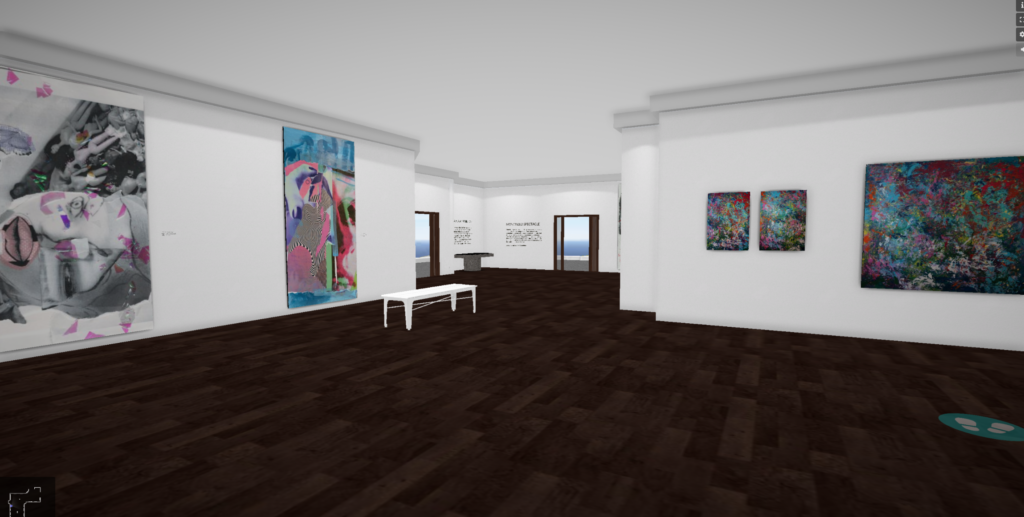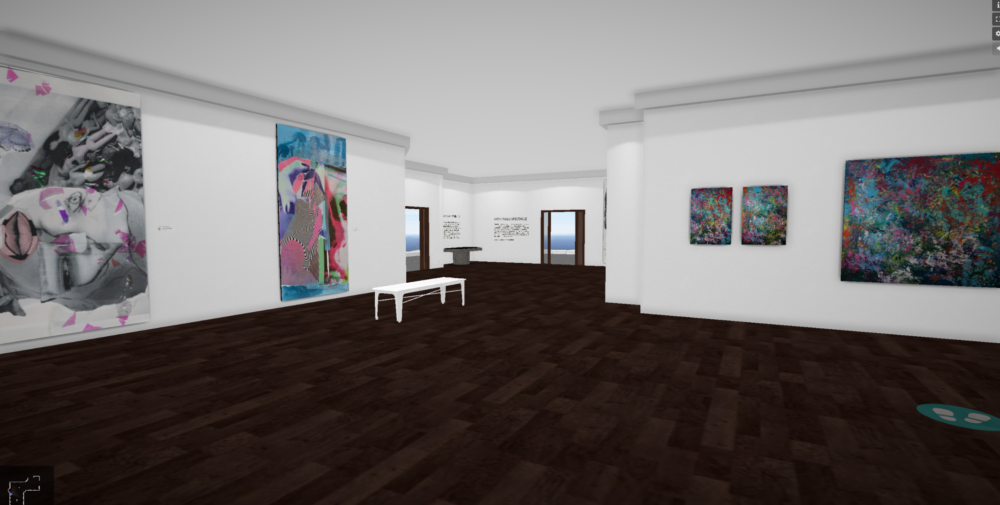2020 Baccalaureate exhibit held over Zoom and Facebook Live

Even though campus is closed, one can still walk through the Baccalaureate exhibit virtually.
When the campus closed in March due to the COVID-19 pandemic, the annual Baccalaureate reception could not take place as it had in years past. Instead of patrons taking in the works and listening to the artists talking about them in person, patrons logged on to Facebook or tuned in on Zoom at 5:30 p.m. March 28.
Using a still photo from the virtual exhibit walkthrough as his Zoom background, Gallery Coordinator Anthony Faris began the gallery’s first-ever webinar thanking those in attendance for their support.
Founding Director of the School of Design, Architecture & Arts Michael Strand gave his opening remarks next, laughing at his own Zoom background choice of the Northern Lights and joking that “us designers need better Zoom backgrounds.”
Speaking of this year’s artists, Jessica Rosenkranz and Laura Powell, Strand applauded their hard work and development over the course of their careers at NDSU, admitting that that is what he says every year. He said that while redundant, it remains true every year.
Strand also explained that due to the unusual circumstances Rosenkranz and Powell will have the opportunity to have their work shown somewhere after the pandemic so people are able to experience them in person.
‘Monetized Spectacle’
Rosenkranz’s exhibition entitled “Monetized Spectacle” is a collection of large mixed media works that explore the unattainable body image that is pushed by advertisements and social media and how it affects the consumer. “Monetized Spectacle is a critique of a cycle that creates the problem it promises to solve,” said Rosenkranz in her artist statement for the collection.
Headless women pose in strappy lingerie while orange flames engulf them in “Pleasure,” while cherubs laugh in tinfoil clouds above a face with tongue out, bleeding pink from the eyes, a vintage pin-up glancing over at the spectacle in “Rebel.”
The large scale of the artwork was intentional as she not only wanted to mimic billboards but also have people experience feeling overwhelmed and lesser than. Rosenkranz explained that this is the feeling that advertisements and social media targeting body image convey to the consumer so they buy their product.
The works are a combination of digital and physical collage work. When she started to create the pieces at the beginning of the semester Rosenkranz started digitally and ended physically, but after having to finish her work at home due to the shutdown her process flipped. This change occurred out of necessity as she no longer had access to large format printers or screen printing.
That is not all that changed with the move to a home studio. Rosenkranz explained that when she started out with the collection not wanting to tell her own story and struggles with body image through the pieces. After the campus closure, however, she said she was needing to be reinspired. The palate of the last three works are less electric and more muted.
One of these works, “Mamma Told Me” is largely black and white with large pieces of holographic pink and purple confetti falling across a bathtub full of barbies and a face which seems to have fashioned a distorted mask from various clippings. This piece was the very last that Rosenkranz finished.
‘Animism’
In her collection entitled “Animism,” Powell explores concepts of spirituality and nature through abstractions of place. In her artist statement, Powell explained that the works “speak to what we can control, what we might relinquish and how we can change to bring balance between the two.”
Bright aqua and turquoise are dabbled with green and punctuated with vibrant pinks, reds and oranges in “Maui,” while tan is brought to life with orange, green, yellow and purple in “Sedona.”
Powell created the pieces as abstract landscapes from pictures or memories of her travels, thinking about the emotion and colors of the place. Each larger piece has at least one smaller accompanying piece meant to show how small parts exist in the bigger picture.
Originally her work was much more realistic, but eventually, she found it was too constricting and moved on to an abstract approach.
Powell explained that her reasoning for using wood instead of canvas was not only because it is much cheaper but also because the paint doesn’t soak in or dry as fast so she was able to blend and work with it longer.
In the future, Powell plans to expand on the concept and possibly add collage elements of a landscape without losing the abstract nature of the work. She is also interested in creating larger scale work.
